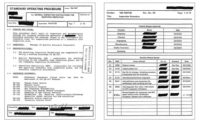This article reviews common practices for, and the positive results of, establishing measurable quality objectives for ISO 9001 and ISO 13485 quality management systems. The author suggests a practical model for identifying and documenting objectives to drive the continual improvement of management systems and increase of customer satisfaction. An example of a Quality Objectives matrix offers a useful format for documenting and monitoring objectives of quality management systems. The paper will be helpful to those organizations that have not yet formally documented their quality objectives and for those that are interested in improving the effectiveness of their quality management systems and the performance of their businesses.
Through my consulting and auditing career I have been collecting "the best and the worst" samples of management systems and QMS documentation. Here are a few examples of the worst quality objectives from my collection:
- "...to deliver exceptional values through trust of the people around the world"
- "...conduct business better, simpler, faster"
- "...quality is paramount and all our employees are committed to quality."
Regretfully, these "quality objectives" are straight from the documentation of some organizations I have worked with. How companies could measure performance against such "objectives" is anybody's guess. I may be overly sensitive to vague and uncertain targets because I've had several bad experiences with such "objectives" in the past.
When I grew up in the former Soviet Union, day and night Soviet propaganda fooled us. The radio and three-channel TV broadcasted non-stop that everything was getting better and better, while we all knew that it was not the case. Since then, I have been unable to figure out how one could say that something is getting better or worse when there is nothing to compare this "something" with.
The wordy quotes above resemble dreams, not objectives. There is nothing wrong with having dreams. Often measurable accomplishments start from dreams. These dreams might include making a computer user interface more intuitive, engineering a car that requires a battery, not a gas tank, automating documentation systems, etc. The problem is that some organizations stop at dreams and don't progress to the quantifiable measurements meaningful to employees, customers, and other interested parties. This was bad news; the good news is that there is a solution.
Let's see how we can translate a dream into measurable objectives on an example of customer needs and requirements. Element 9.1.2 of the ISO 9001 2015 standard, among others, requires monitoring "… customers’ perceptions of the degree to which their needs and expectations have been fulfilled." ISO 13485 2016 element 7.2.1 requires determination of “… a) requirements specified by the customer, …” Such determination and monitoring are a good idea because standards require them and because happy customers continue paying the bills. Often companies establish their customer satisfaction targets to 87, 97 or whatever percent. What those percentages mean, my apologies, I have no idea. Making conclusions, based on satisfaction surveys data, can be far too subjective. If a customer marks 87 today, she or he can mark 76 tomorrow just because it is rainy.
Fortunately, there is an alternative way to translate customer needs and requirements into measurable specifics. Since we all are "professional" customers we can confidently say that to make a customer pleased, we just need to give your customers:
- What they asked for,
- When they wanted it,
- The product functions for an expected period of time, and
- Give it to them for the price they believe is honest.
These characteristics are more specific and may, in summary, represent a meaningful base for measuring customer perceptions. In the systems compliant with the new 9001 2015 standard, these measurements will also come from the definition of “Understanding the needs and expectations of interested parties” per the element 4.2.
Quantifying Quality Objectives
If we agree that the objectives above leading to happy customers are a good start, let's see how we can quantify them.
- "Give them what they asked for" may be quantified by the number of product returns with the reason "wrong part" or similar.
- "When they want it" may be easily measured through variance between the actual delivery date and the confirmed or promised date.
- “The product functions for an expected period of time” may be measured by Mean Time Between Failures (MTBF) or warranty costs.
- "The price they believe is honest" may be expressed as a variance between our price and the average of compatible products. This data can be obtained through periodic competitive price surveys.
Responsibility: Anybody Could Have Done It...
Now that we have developed a list of quality objectives and know how to measure them, we should consider perhaps the most important feature of any task: accountability. Remember the story about those three guys, Everybody, Anybody, and Nobody? When hell broke loose and Everybody knew what needed to be done, Anybody could have done it, but Nobody did.
The moral of the story is simple: if you need to get something done, make a particular employee, not a committee or a department accountable for it. When something needs to be accomplished it shouldn't be handed over to "collective responsibility." Since every company wants to achieve its objectives and goals, every company can start by assigning specific responsibilities to specific employees, depending on their expertise and authority within the organization. For example, the most appropriate position to oversee and report delivery accuracy is most likely the Shipping Manager or the Customer Service Manager. The most appropriate person to report on customer retention is the Customer Service Manager; the most appropriate person to report on pricing may be the VP of Marketing, etc.
Review Frequencies
Now that we have identified our objectives and related responsibilities, we need to define practical frequencies for the review of each objective. These reviews, or performance appraisals, are usually conducted by management or lower tactical forums. Top-level management reviews are conducted monthly, quarterly or annually, while tactical reviews on departmental or team levels may be conducted daily, weekly, monthly or quarterly.
Setting Frank Quality Goals
There is a saying: "Be careful what you wish for — you just may get it!" If this is true and we wished we could deliver our products 100% on-time it could come true! Unfortunately, this wisdom is not for everybody. Once I worked with a company that took the opposite approach. When I interviewed the Order Processing Manager and examined their records, I learned that their delivery accuracy was somewhere around 60 percent with delays of up to 30 days. "What are your goals in improving delivery?" I asked. "Reach 80 percent," the manager replied. "How often do your customers want shipments on time?" I asked. "All the time," she replied. "Why is your goal not 100 percent then?" I asked. "It will de-motivate employees to miss the goal most of the time," she answered.
It was very thoughtful of the manager and the entire organization to be concerned with their employees' morale and motivation but contradictory to the company's policy to "meet or exceed customer needs and expectations." Do we stop aiming at the center of the target when we're shooting darts even if we do not hit the center every time? Sometimes I wonder why some organizations apply different standards to their customers, employees, and suppliers than to themselves. Wouldn't it be fair to target 100 percent on-time delivery when we ourselves expect our employer to be 100 percent on-time with our paychecks?
Afterward
By using the simple approaches addressed in this paper, you may develop a powerful quality management tool that will allow your business to assess its performance based on data and not feelings. As a matter of fact, my most successful clients use full-blown Balanced Scorecards to manage their quality, business, and other objectives. Such scorecards may be used for quality, environmental, process realization and other business systems.
As a centuries-old Chinese saying goes, “A Journey of a Thousand Miles Begins with a Single Step”. I hope this information helps to realize how measurable objectives, targets and periodic reviews may lead to the achievement of business goals. Aim high, do not be afraid of missing targets (sometimes) and good luck in reaching your measurable quality objectives using the Quality Objectives matrix below.
For more information, visit https://leanisomanagementsystems.com/academy.php.
*This article was originally published by Master Control on October 6, 2010 and this revision is an update to reflect on the new requirements of ISO 9001 2015 and ISO 13485 2016.



